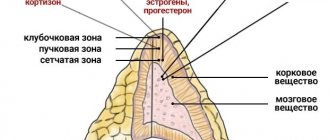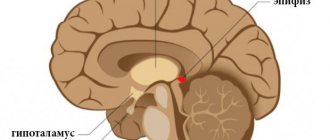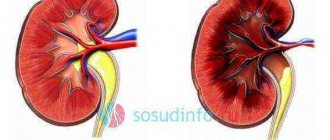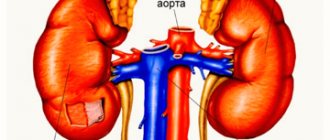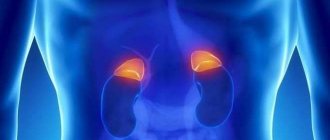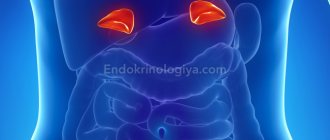The adrenal glands are small glands that fit tightly to the tops of the kidneys, hence their name.
Despite the fact that they weigh only 7-10 grams, their importance in the body is difficult to overestimate.
This article provides information about the hormones and functions of such an important organ as the adrenal glands in the human body.
Adrenal hormones
The cells of the adrenal glands produce a number of hormones necessary for the full functioning of the body.
Hormones of the adrenal cortex:
- zona glomerulosa – mineralocorticoids (water-salt metabolism);
- zona fasciculata – glucocorticoids (metabolism and energy);
- reticular zone – androgens (sexual functions).
Adrenal medulla hormones:
- adrenalin,
- norepinephrine.
Currently, over 50 active substances have been isolated in the adrenal glands, whose function is still being studied.
Cortisol (K)
Cells of the adrenal cortex take part in the production of the hormone. It belongs to the category of glucocorticoids. It is cortisol that is responsible for controlling the production of ACTH and corticoliberin.
Cortisol is characterized by strong daily fluctuations:
- the maximum is observed from four o'clock to eight in the morning;
- minimum - from nine in the evening to three in the morning.
When is the test taken?
Blood donation for cortisol is prescribed:
- with hirsutism;
- to confirm Itsenko-Kuchinga syndrome and Addison's disease;
- with oligomenorrhea;
- with accelerated puberty;
- for osteoporosis;
- with increased skin pigmentation;
- with unexplained muscle weakness.
How to donate blood for cortisol
What conditions must be met? The day before the test, you should stop (if possible) taking the following medications:
- estrogens;
- drugs from the category of opiates;
- contraceptives.
Also, on the eve of visiting the laboratory, you should avoid active sports and smoking.
Advice! It is the measurement of the daily amount of cortisol in the blood that is a mandatory blood test if Cushing's syndrome is suspected. An increased level of this hormone of the pituitary-adrenal system is characteristic of this pathology.
What are the normal levels of cortisone in the blood?
The norm of indicators depends on the age of the person:
- under 16 years old - 83...580 nmol/l;
- over 16 years old - 138...635 nmol/l.
Deviations from the norm
Elevated numbers may indicate the presence of:
- Itsenko-Cushing's disease;
- adrenal cortex carcinoma;
- blood sugar levels drop below acceptable levels;
- adrenal tumors;
- decreased kidney function;
- virilizing hyperplasia of the adrenal cortex;
- hyperthyroidism.
Increased cortisone levels are observed:
- during pregnancy;
- while taking oral contraception;
- for stress and depression;
- if you are overweight;
- with alcoholism.
A decrease in indicators may confirm:
- adrenogenital syndrome;
- disruption of the synthesis of corticosteroids by the adrenal glands;
- insufficient production of hormones by the adrenal glands (Addison's disease);
- panhypopituitarism;
- hepatitis;
- cirrhosis of the liver;
- hypothyroidism.
A reduced rate during pregnancy may indicate the development of early toxicosis.
Mineralocorticoids
Mineralocorticoids, produced in the zona glomerulosa of the adrenal cortex, are involved in the regulation of water-salt metabolism. The most famous of them are aldosterone and deoxycorticosterone. In the body, they are responsible for regulating the exchange of water and electrolytes - they promote sodium retention and potassium excretion: in the renal tubules, aldosterone increases the reabsorption of sodium and reduces the reabsorption of potassium. It has a similar effect on the sweat, salivary glands and colon. This increases the concentration of sodium in the blood and decreases the amount of potassium. Due to the fact that sodium “pulls” water onto itself, water retention and an increase in blood pressure also occur. At the same time, aldosterone is considered the most powerful mineralocorticoid and is 50-100 times superior to deoxycorticosterone.
Other effects of mineralocorticoids:
- retention of chlorine in the body;
- removal of hydrogen and ammonium ions;
- alkalization of the internal environment of the body (increase in blood pH, shift towards alkalosis).
Mineralocorticoid deficiency is observed in diseases such as Addison's disease, congenital deficiency of enzymes involved in the formation of adrenal hormones, Waterhouse-Friderichsen syndrome.
Typical symptoms of aldosterone deficiency (hypoaldosteronism):
- increased loss of sodium and water by the body;
- excessive decrease in extracellular fluid volume;
- increased fatigue;
- low blood pressure;
- rapid heart rate (tachycardia);
- headache;
- potassium retention – the occurrence of cardiac arrhythmias and muscle spasms.
Excess mineralocorticoids are most common in certain hereditary diseases or in cases of aldosterone-producing tumors. Characteristic symptoms of hyperaldosteronism:
- sodium retention;
- loss of potassium and magnesium;
- high blood pressure;
- swelling;
- constipation;
- muscle weakness;
- involuntary, painful muscle contractions (tetany);
- changes on the ECG.
In recent years, other functions of mineralocorticoids have been discovered - enhancing inflammatory reactions and stimulating the immune system. In addition, aldosterone is important for the formation of connective tissue collagen, and deoxycorticosterone increases endurance and strength of skeletal muscles.
The regulation of mineralocorticoid production is carried out as follows:
- Stimulate aldosterone synthesis:
- Low blood pressure through the renin-angiotensin system. The main components of this system are renin, angiotensinogen, angiotensin I and angiotensin II. If blood pressure drops below a certain level, renin is produced in the cells of the juxtaglomerular apparatus of the kidneys, which enters the blood and lymph. This renin is necessary to convert angiotensinogen, produced primarily by the liver, into angiotensin I, which is then converted into angiotensin II. And it is angiotensin II that stimulates the formation of aldosterone in the zona glomerulosa of the adrenal glands.
- Low sodium concentrations in the blood.
- Glomerulotropin, produced by the pineal gland.
- Inhibits the formation of aldosterone:
- High concentration of sodium in the blood.
- Low potassium concentration in the blood.
- Increased volume of blood plasma and tissue fluid.
- Atrial natriuretic hormone.
How foods and diet affect
Various serious diseases can be caused by malfunctions of the adrenal gland. Hypofunction of the paired gland cortex has its own symptoms. For treatment, you must seek medical help. After an examination, including tests for hormone groups, the doctor will prescribe appropriate treatment. Medicines selected by a doctor should be taken strictly according to the prescribed regimen.
It is also necessary to pay attention to diet and products. Some products may be harmful. An incorrect diet will not only not help in treatment, but may even worsen the situation.
The correct diet and diet should be agreed upon with a specialist based on the patient’s individual health indicators. There are certain leaflets that contain competent recommendations on approved products for feeding patients with a particular diagnosis.
Glucocorticoids
Hormones of this group have a direct effect on the metabolism of nucleic acids, as well as proteins, fats and carbohydrates. Glucocorticoids include the following hormones:
- cortisol (hydrocortisone);
- cortisone;
- corticosterone;
- 11-dehydrocorticosterone;
- 11-deoxycortisol.
The most famous functions of glucocorticoids in the body:
- increased blood glucose levels;
- antiallergic effect;
- pronounced anti-inflammatory effect;
- antipyretic effect;
- stimulation of red blood cell formation;
- suppression of immune and autoimmune reactions;
- inhibition of connective tissue growth (inhibition of collagen and scar formation);
- stimulation of the utilization of muscle tissue proteins, their formation in the liver and redistribution of fats in the body;
- increased concentration of fatty acids in the blood;
- anti-shock effect;
- increased synthesis of catecholamines produced in the adrenal medulla.
In addition, glucocorticoids play an important role in adaptation and stressful situations, and also have a weak mineralocorticoid effect, including increasing blood pressure and retaining sodium, chlorine and fluid ions in the body. Cortisol has the most powerful glucocorticoid effect.
A lack of hormones in this group is observed due to the destruction of the adrenal cortex due to autoimmune aggression, tuberculosis, traumatic injuries to this area, decreased secretion of adrenocorticotropic hormone (ACTH), various tumors or long-term use of drugs containing corticosteroids.
Most often this condition manifests itself:
- rapid heartbeat;
- decreased blood pressure;
- chronic fatigue, worsening in the evening;
- muscle weakness;
- hyperpigmentation of the skin in the form of individual spots;
- decrease in blood glucose levels.
If glucocorticoid deficiency is not very pronounced, then these symptoms appear only during times of increased need for them in the body, for example, during various types of stress, injury, surgery or acute infectious diseases.
An excess of glucocorticoid hormones occurs in the case of hormonally active tumors of the adrenal tissue, increased formation of ACTH, chronic alcohol intoxication, obesity and some neuropsychiatric diseases. It may manifest itself:
- osteoporosis;
- increased blood glucose levels and steroid diabetes;
- excess fat deposition mainly in the torso, face and neck;
- arterial hypertension;
- increased susceptibility to infection;
- sleep disturbance;
- mood changes;
- ulceration of the gastric mucosa;
- suppression of the immune system.
The regulation of glucocorticoid hormones is directly carried out by adrenocorticotropic hormone (corticotropin, ACTH), which is produced in the pituitary gland. At the same time, low concentrations of glucocorticoids increase the production of ACTH, and high concentrations suppress it. Therefore, in the first case, the adrenal glands will respond by increasing the production of glucocorticosteroid hormones, and in the second case, by inhibition.
Normally, the adrenal glands do not synthesize cortisol constantly, but cyclically, with about half of its total amount occurring during the period of morning sleep. In addition, activation of the synthesis of glucocorticoid hormones increases under stress, neuropsychic stress, trauma, blood loss and shock.
Dehydroepiandrosterone
Dehydroepiandrosterone is an androgenic steroid hormone produced by cells of the adrenal cortex. It is the prohormone, which, due to complex processes, is transformed into the main male hormone - testosterone and the female hormone - estrogen.
Norm of indicators
The indicators have a fairly wide range and depend on age. The test systems used and the blood analyzers themselves may cause some errors. The following are considered the norm:
- in women – 810-8991 nmol/l;
- in men – 3591-11907 nmol/l.
When are they appointed?
A blood test for this hormone of the pituitary-adrenal system is prescribed for:
- suspicion of existing disturbances in the production of their own corticosteroids by the adrenal glands;
- tumors of the adrenal cortex;
- miscarriage;
- fetal malnutrition;
- existing symptoms of delayed sexual development;
- suspected excess levels of hormones of the pituitary-adrenal system in a pregnant woman.
How to prepare for the test
Before donating blood for adrenal hormones, you must stop taking the following medications:
- "Dexamethasone";
- "Hydrocortisone";
- "Prednisolone";
- "Diprospan";
- estrogens;
- tablet contraception.
Advice! To make the result more accurate, you need to inform the nurse about the medications you are taking that can affect the biochemical composition of the blood.
Adrenal sex hormones
A small amount of progesterone is synthesized in the adrenal glands.
It is especially important in childhood and adolescence, as well as during menopause. Sex hormones produced by the adrenal cortex include progesterone, androgens and estrogens. However, all of them are synthesized in fairly small quantities, since their main production occurs in the sex glands - the female ovaries and male testicles.
Progesterone
In the adrenal glands it is a precursor of androgens and estrogens. In addition, it can take part in the synthesis of 11-deoxycorticosterone (after a series of chemical transformations it is converted to aldosterone), 11-deoxycortisol (a precursor of cortisol) and Δ4-androstenedione (from which testosterone, estradiol and estrone are subsequently formed).
Adrenal progesterone is especially important for the body in childhood and adolescence, as well as after the extinction of the function of the gonads. In addition, being a neurohormone, it can influence mood.
Estrogens
The adrenal glands themselves produce a small amount of them, but they play the most important role until the production of estrogen by the gonads begins. Their main role is participation in the formation of secondary sexual characteristics.
Androgens
In men, the adrenal glands account for about 1/3 of the total amount synthesized in the body. The main androgens produced in the adrenal glands are dehydroepiandrosterone (DHEA), dehydroepiandrosterone sulfate (DHEA-S), androstenedione and testosterone, with DHEA and DHEA-S making up the lion's share. They are then converted into testosterone, which is 10 times more potent than its predecessors. In subcutaneous fat, mammary gland and hair follicles, adrenal androgens can be converted into estrogens, in particular estrone. And in pregnant women, DHEA and DHEA-S are converted into estrogens in the placenta and provide up to 90% of the synthesis of estriol and up to 50% of estrone and estradiol there.
In addition, androgens promote protein synthesis and are therefore important for building muscle tissue.
An excess or deficiency of sex hormones is observed in the case of hyper- or hypocortisolism and various hormonally active tumors. The leading signs of increased or decreased secretion of adrenal sex hormones are:
- problems with conception and pregnancy;
- genital dysfunction;
- adrenogenital syndrome of hetero- or isosexual type.
In the case of the isosexual type of adrenogenital syndrome, excessive synthesis of hormones of the same sex is observed, which is accompanied by an acceleration of puberty. And with the heterosexual type, sex hormones of the opposite sex are produced in excess, therefore characteristics characteristic of the other sex develop.
Adrenocorticotropic hormone stimulates the production of sex hormones by the adrenal glands.
Functions in the body
An important task of the complex of bioactive substances is to maintain the constancy of physiological processes, ensure optimal functioning of systems, and prevent metabolic disorders. A change in the level of one regulator often affects the secretion of other components (TSH, T3 and T4, somatotropin and bioactive substances of the thyroid gland, ACTH and adrenal hormones).
Hormones perform many important functions:
- regulate glucose concentration,
- activate immune defense,
- affect metabolic processes and weight stability,
- help the body cope with shock, stress, heavy physical activity, vigorous activities,
- ensure the growth of various types of tissues: muscles, bones, affect the regeneration of hair, skin, mucous membranes, nails,
- regulate behavioral reactions and mood,
- support tissue energy supply,
- help a person feel the change in circadian rhythms,
- prepare the body for the beginning of a new life stage: puberty, menopause,
- maintain a sufficient level of sexual desire, prevent erectile dysfunction,
- influence the stability of the cycle, prepare the body for conception, maintain pregnancy, ensure the correct course of labor,
- control appetite, feelings of satiety and hunger.
What does an elevated tumor marker CA 19 9 mean and what diseases does it indicate?
We have the answer! About what medications to take during menopause for hot flashes and how to alleviate the condition during hormonal changes is written on this page.Follow the link https://fr-dc.ru/lechenie/medicamenty/siofor.html and read the instructions for using Siofor tablets for type 2 diabetes.
Brain hormones
The adrenal medulla synthesizes catecholamines: dopamine, norepinephrine and adrenaline. All of them are formed from the amino acid tyrosine through a series of sequential transformations:
tyrosine→DOPA→dopamine→norepinephrine→adrenaline.
Dopamine
Although dopamine is one of the important chemical compounds of the nervous system, when formed in the adrenal glands, it practically does not penetrate the blood-brain barrier. Therefore, dopamine from the adrenal glands does not affect brain function and is more needed for the production of norepinephrine.
Norepinephrine
This catecholamine is formed mainly in the endings of the sympathetic nerves, in small quantities, directly in the adrenal medulla. It is important for the formation of adrenaline, and by connecting with alpha-adrenal receptors of vascular cells, it causes the following effects in the body:
- pronounced vasoconstrictor effect on blood vessels;
- increased blood pressure due to contraction of vascular smooth muscle.
In addition, norepinephrine, although to a lesser extent, increases the pulse rate, stimulating heart contractions, and slightly contracts the muscles of the bronchi and intestines.
Adrenalin
One of the effects of adrenaline is to increase the excitability of the nervous system and sensory organs.
It is the main substance produced in the adrenal glands: it accounts for 80% of all catecholamines that are synthesized here. Unlike norepinephrine, it also affects metabolism - it increases blood glucose levels, participates in fat burning, etc.
Other effects of adrenaline:
- relaxation of bronchial muscles, easier breathing;
- increased heat production;
- increased and increased heart rate;
- redistribution of blood in the body: the vessels of the skin and abdominal cavity narrow, and the brain, heart and skeletal muscles expand;
- mobilization of energy resources;
- increased excitability of the nervous system and sensory organs.
Catecholamines, which are produced in nerve cells, as well as in the adrenal medulla, constitute a single sympathoadrenal system in the body, responsible for adapting the body to stress loads and providing the necessary response in “fight or flight” situations or emergency circumstances.
Their production increases in case of a feeling of danger, fear, in stressful situations, with burns, injuries, shock, and increased physical activity.
A deficiency of adrenaline and norepinephrine is accompanied by general weakness, increased fatigue, slowed reactions, lower blood pressure and slow heart rate. Excess can lead to hyperactivity disorder (ADHD), sleep disturbances, and a higher level of emotional lability.
Blood analysis
The functionality of the entire body depends on the full functioning of these small glands. A blood test for adrenal hormones can be prescribed by different doctors:
- oncologist;
- gynecologist;
- therapist;
- endocrinologist;
- urologist;
- cardiologist.
Depending on the clinical picture, the doctor prescribes a laboratory test to determine the concentration of a specific hormone. To obtain reliable analysis results, preliminary preparation is required. A few examples:
- To test for aldosterone, you need to reduce your carbohydrate intake within two weeks;
- Before donating blood for cortisol, hormonal medications are canceled, physical activity is excluded, and smoking is prohibited;
- To determine catecholamines, coffee, strong tea, cheese, and bananas are excluded from the diet before blood sampling.
Additional adrenal glands
Sometimes additional formations can be found in the body that contain tissue from the cortex, medulla, or cortex and medulla of the adrenal glands and produce the corresponding hormones. They can be located in the area of the kidneys, solar plexus, pelvis, along the aorta, in the broad ligament of the uterus or spermatic cord, as well as in any other place. Being hormonally active structures, they can contribute to the supply of glucocorticoids, mineralocorticoids, sex hormones and catecholamines to the body.
Research methods
First of all, an analysis of adrenal hormones will help evaluate the functioning of the glands.
In this case, the main biomaterials for research are the patient’s blood and urine. Tests can be carried out either with or without stimulation with additional drugs.
The level of the following adrenal hormones is determined in the blood serum:
Each of them performs its own function and is responsible for different processes in the body.
Urine tests are performed to determine daily fluctuations in cortisol. Often, medications are used that help identify the root cause of deviations from the norm, that is, where the pathology is located - in the adrenal glands or in the brain. In rare cases, the level of this hormone is determined in saliva. This approach is used for some diseases (mainly the thyroid gland), since urine or blood tests are not very informative.
In addition to laboratory methods for assessing the functioning of the adrenal glands, instrumental ones are also used. The most common of them is ultrasound of the kidneys and adrenal glands. But one of the disadvantages of this method is poor visualization of organ tissue. Therefore, small formations often go unnoticed.
Due to these circumstances, the most preferred methods for studying the adrenal glands are CT and MRI with and without contrast. Examinations allow us to examine the organ and even the smallest inclusions in detail, evaluate the functioning of the circulatory system and identify its physiological defects.
And only in very rare cases, to check the functioning of the adrenal glands, it may be necessary to use instrumental techniques (laparoscopy, endoscopy, etc.).
Adrenal glands: symptoms, treatment of the disease in women and men – About the Kidneys
- To get a detailed idea of how the adrenal glands hurt and the symptoms that accompany the progression of the disease, it is worth turning to the nature of the hormonal imbalance that occurred in the patient’s body.
- Manifestations of diseases of the glands located above the kidneys have their own characteristic features, which are determined by the lack or excess of production of a specific hormone in the body.
- For example, when there is a deficiency in aldosterone production, sodium leaves the body along with urine, which, in turn, causes a decrease in blood pressure.
When cortisol begins to be produced in quantities beyond normal limits, a serious disease develops - adrenal insufficiency. In severe clinical cases, it can threaten the patient's life.
- Timely recognition of the symptoms of adrenal diseases is the main condition for effective treatment and a positive prognosis.
- Diseases of the glands occur both with and without hormonal dysfunction.
- The lack of hormones that cause pain and other symptoms is provoked by adrenal insufficiency of the primary or secondary type, acute or chronic.
Adrenal hormones
Excess hormones usually occur for other reasons, including:
- various tumors of the brain zone;
- neoplasms of the zona fasciculata, glomerulosa and reticularis;
- mixed type tumors;
- dysfunction and hypertrophy of the adrenal cortex.
In other cases, pathologies of the glands occur without significant problems on the part of the endocrine system due to the formation of tumors that do not have hormonal activity.
Signs of gland dysfunction
To determine how the adrenal glands hurt, and most importantly, what symptoms are inherent in the diseases, you will need to consider in detail the pathologies diagnosed in patients and the consequences of their development.
Arterial pressure
At any age, you should listen to your body and the idea that the glands are not working correctly. The following symptoms should alert you:
- fatigue too quickly;
- muscle weakness and increased incidence of cramps;
- irritability and nervousness;
- disturbances from the central nervous system;
- dyspeptic disorders;
- low or high blood pressure;
- the appearance of pigmented areas of the body, usually not covered by clothing.
- These symptoms are more or less characteristic of adrenal diseases, which are described in more detail below.
- One of the most common pathologies of the adrenal glands, the symptoms of which most patients experience, is Addison's disease.
- As already mentioned, the disease develops as a result of primary or secondary adrenal insufficiency.
Pituitary
In the first case, we are talking about damage to the tissues of the glands themselves, in the second - in diseases of the brain, the consequence of which is the involvement of the pituitary gland or hypothalamus.
If we take the statistics of diagnoses as a basis, then clinical cases of Addison's disease for the primary type of deficiency are recorded by an order of magnitude less than for the secondary type, which is not characterized by skin pigmentation.
Symptoms and pain in the adrenal glands may not appear for a long time. Various factors can provoke insufficient functioning of the glands, but the main reason is considered to be a weakening of immune forces.
At the same time, the following diseases can cause Addison's disease of the adrenal glands:
- tuberculosis of the kidneys and adrenal glands;
- damage by fungal microorganisms;
- HIV AIDS;
- disruptions of protein metabolism;
- complete or partial removal of glands.
Adrenal insufficiency
The main manifestations of adrenal insufficiency in developing Addison's disease include the following symptoms:
- weakness in the body after experiences;
- lack of appetite;
- weight loss;
- development of susceptibility to viral respiratory infections;
- intolerance to ultraviolet rays;
- darkening of nipples, lips, mucous membranes;
- tachycardia with hypotension;
- increased frequency of urges to go to the toilet at night.
It is also worth noting that men and women often experience headaches and decreased libido. Patients note disturbances in brain activity, memory, and decreased concentration.
In addition, in women over 30 years of age, hair loss occurs in the armpits and groin.
How to recognize hyperaldosteronism?
The pathology is a dysfunction of the adrenal glands caused by increased production of the hormone aldosterone.
Liver disorders, as well as kidney or heart failure, leading to adrenal dysfunction, could negatively affect the functioning of the glands and cause illness.
Arrhythmia
- As well as damage to the pituitary gland and the growth of cancerous tumors, a long course of the infectious process.
- The symptoms of hyperaldosteronism progress, and at some point it becomes impossible not to notice them.
- Signs of this adrenal disease can be called:
- muscle hypotonicity;
- migraine and headache;
- cardiac arrhythmia and tachycardia;
- constant feeling of weakness, fatigue even after sleep;
- increased urge to go to the toilet;
- convulsions;
- swelling of the limbs;
- stool disorders.
Features of Itsenko-Cushing syndrome
Itsenko-Cushing syndrome is rather not called an independent disease of the adrenal glands.
This symptom complex is often a consequence of a neoplasm or malignant tumor of another organ. The main signs of Itsenko-Cushing syndrome, which is more common in women, are:
Itsenko-Cushing syndrome
- development of arterial hypertension;
- increase in body weight in “male” areas;
- acquisition of a moon-shaped face;
- disruptions in glucose metabolism;
- atrophy and decreased tone of muscle tissue;
- absence of menstruation;
- development of osteoporosis;
- cephalalgia, migraine;
- impaired blood supply, fragile capillaries;
- hair growth in places uncharacteristic for women (growth of a beard, mustache).
Symptoms of Nelson's disease
Nelson's syndrome is a pathological condition of the adrenal glands, with their pronounced dysfunction, which develops as a consequence of the removal of the glands in Itsenko-Cushing syndrome.
Aldosteroma
A characteristic feature of Nelson's disease is a decrease in visual abilities, their sharpness, deterioration in the functioning of taste buds, and almost constant headaches.
With Nelson's syndrome, increased pigmentation of certain areas of the skin occurs.
Tumors are among the most commonly diagnosed problems with the adrenal glands. Neoplasms of various natures (benign and malignant) carry serious complications and risk to the patient’s life.
In most cases, benign tumors are diagnosed during the examination, including:
- aldosteroma;
- glucocorticosteroma;
- pheochromacytoma;
- corticoestroma.
The symptoms of adrenal tumors have many of their own characteristics in comparison with the general clinical picture that occurs when the glands are insufficient.
In addition, without knowing anything about the causes of the disease, it is quite difficult to take any therapeutic actions to relieve symptoms.
Since the main task of the adrenal glands is undoubtedly the production of hormones that affect metabolism, blood pressure levels, the manifestations of neoplasms largely depend on the excessive production of a particular substance.
Most often, the symptoms of a tumor disease of the adrenal glands become obvious:
- constantly erratic heart rate;
- loss of strength and muscle atrophy;
- increased frequency of urinary stools at night;
- increased sweating;
- panic attacks;
- fear;
- dyspnea;
- nagging pain in the lumbar region;
- pale skin;
- change in appearance, acquisition of features of the opposite sex;
- a feeling of aching in the joints, cyanosis of the tissues;
- convulsions and chills, unceasing trembling.
Dry mouth is a consequence of elevated blood sugar levels. In the absence of any therapeutic actions aimed at combating the growing tumor, the patient can expect complications in the form of a stroke, pulmonary edema, or hemorrhage in the retina.
Diagnostic procedures
The manifestation of symptoms due to adrenal dysfunction can often be observed when the pathology has long passed the initial stage of its development.
MRI
So, to diagnose a disease, you will need a whole range of research procedures. The attending physician prescribes the diagnosis.
As a rule, to make a correct diagnosis, the patient will have to:
- Be tested for hormones to determine which substances predominate in the blood and which are deficient;
- Undergo ultrasound screening of the kidneys and adrenal glands, which can detect the presence of tumors;
- To recognize their nature, the patient may be prescribed an MRI or CT scan.
The results of the study allow the doctor to obtain a detailed picture of the disease and make attempts to determine the causes of the disease.
If disturbances have occurred in other systems of the body, treatment is tailored taking into account this factor. Conservative therapy or surgical intervention is carried out in accordance with the symptoms of adrenal diseases.
Treatment and prevention
To restore the patient’s health, the actions of specialists are primarily aimed at eliminating the main provoking cause of the pathology, establishing the normal functionality of the glands, and then establishing a normal hormone level.
In the initial stages of the development of adrenal diseases, glandular insufficiency and mild symptoms, doctors prescribe medications.
Synthetic hormones, which are taken under medical supervision, over time restore the existing deficiency or excess of substances.
- If drug treatment does not produce any results over a certain period of time, patients are shown surgery, which usually involves removing one or both diseased glands.
- For any disease of the adrenal glands, the doctor and the patient have only two options: to intervene in the cavity using an endoscope or to perform a more traumatic operation that involves a deep tissue incision.
- The consequence of cavity penetration will be prolonged healing.
Laparoscopic procedure
The laparoscopic procedure is less invasive and allows for faster rehabilitation.
If treatment is started on time, the prognosis for recovery is favorable. Failures caused by other disorders in the patient’s body can complicate the recovery process.
Speaking about the prevention of diseases caused by adrenal insufficiency and preventing the manifestation of symptoms, it should be understood that the following measures will be the best ways to prevent the disease:
- avoidance of stressful situations, worries and worries;
- adherence to the basics of a healthy lifestyle;
- undergoing periodic comprehensive examinations;
- turning to specialists at the first suspicion, without experiments and self-medication.
Only high-quality therapy will put an end to adrenal diseases and prevent the onset of consequences dangerous to the health and life of the patient.
Source:
Adrenal glands: symptoms and causes of the disease, their diagnosis and treatment
- The adrenal glands are a paired organ in the endocrine system, designed to keep all functions in the body under control.
- The development of one or another pathology in a given organ can lead to various diseases in men and women, and even the development of oncology.
- The role of the adrenal glands is great; failure of functionality requires regulation and treatment, preferably at an early stage.
What is the role of the adrenal glands?
One of the important organs of the endocrine system is located in the abdominal cavity behind the kidneys. Consists of two structures: the cortex and the medulla.
The cortex, located in 3 zones: reticular, fascicular and glomerular, performs different functions:
- in the zona glomerulosa, hormones are produced (aldosterone, corticosterone, deoxycorticosterone);
- in the zona fasciculata – corticosterone;
- in the reticular zone – the secretion of sex androgens (glands) is active; influencing libido, increasing strength and muscle mass; in men, regulation of lipid and cholesterol levels in the blood.
The cortical substance promotes:
- synthesis and production of hormones (cortisol and corticosterone), in particular sex hormones;
- maintaining water and electrolyte balance under control. The cortex is responsible for the production of corticosteroid hormones. The medulla is designed to synthesize;
- production of norepinephrine, adrenaline and increased blood glucose;
- stimulation of the heart muscle;
- regulation of blood pressure;
- dilation of the bronchi.
In general, the adrenal glands in men are actively involved in:
- formation of genital organs in men;
- regulation of water and electrolyte balance;
- maintaining normal blood pressure;
- increasing the efficiency of muscle strength;
- increased blood sugar levels.
Source: https://uroscope.ru/bolezni-organov/nadpochechniki-simptomy-lecheniya-zabolevaniya-u-zhenshhin-i-muzhchin.html
Gland dysfunction
Disturbances in the functioning of the adrenal glands affect the functioning of the entire human body. The following signs may indicate gland dysfunction:
- chronic condition of fatigue;
- muscle weakness;
- increased irritability;
- sleep disorders;
- anorexia or obesity;
- nausea, vomiting;
- increased blood pressure;
- the appearance of pigment spots;
- hair loss.
If you suspect problems with the adrenal glands, you should consult an endocrinologist.
With normal functioning of the glands, the body can resist the effects of adverse factors. The organ regulates metabolic processes, so its dysfunction is often accompanied by obesity. It controls not only fat, but also muscle mass, stimulating an increase in its volume. One of the most important functions is the ability to adapt to stress and recover from it. The immune system is also under the control of the adrenal glands.
It is important to pay attention to the prevention of diseases that can affect the condition of the adrenal glands and the development of various pathologies. First of all, these are autoimmune diseases: HIV, lupus. Growths, cysts, and tumors of both malignant and benign nature may also develop.
Paired glands that differ from each other in shape and are located above the upper pole of the kidneys are the adrenal glands. Adrenal glands, functions in the body:
- maintaining mineral metabolism and water-salt balance;
- hormone production;
- provision of sexual functions.

